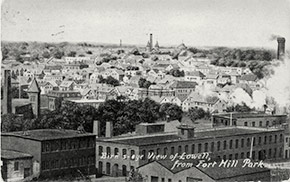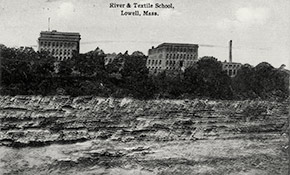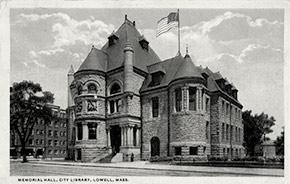Produced by the University of Michigan Center for the History of Medicine and Michigan Publishing, University of Michigan Library
Influenza Encyclopedia
The American Influenza Epidemic of 1918-1919:
A Digital Encyclopedia
Lowell, Massachusetts
50 U.S. Cities & Their Stories
As in many Massachusetts cities and towns, Lowell responded immediately to State Health Commissioner Eugene R. Kelley’s September 20 request to receive reports of influenza cases and deaths. Going one step further, Lowell’s Board of Health made the disease reportable on September 20 and immediately filed the city’s first official case and informed the state.1,2 Taking no chances, several hospitals in the city banned visitors the next day. But the nature of this infectious beast was explosive and by September 24, the number of new cases reported daily exceeded 100.3
Two days later, Mayor Perry D. Thompson called a meeting to see how to minimize the spread of infection in Lowell. The leaders Mayor Thompson drew together were members of the Board of Health, the School Department, and the Public Safety Committee. Together, they decided to close schools, theaters, and movie houses for at least the rest of the week, to add beds for influenza cases at several hospitals, and open an emergency hospital devoted entirely to influenza cases. After the meeting, Thompson called theater managers to his office, where they pledged hearty cooperation for the goal of influenza prevention.4
Mayor Thompson also contacted Major-General H. P. McCain, commanding officer at Camp Devens, only 18 miles from the city, to discuss ways to prevent the spread of infection between the military and civilians.5 By this time, there were at least 10,000 stricken at the camp, which made national headlines daily because of the devastating sickness and loss of life, and the desperate race to supply the camp with enough medical personnel. Camp Devens men weren’t paying social calls in any Massachusetts towns by that time.6
On September 29, the Board of Health and the Public Safety Committee met again and this time included Charles E. Simpson, the district’s State Department of Health representative. One result was a ban on public gatherings, excluding church services. They also determined that the city’s new isolation hospital, still under construction, was the best place to set up the emergency hospital. When officials tapped this unfinished isolation hospital as an emergency influenza hospital and declared its readiness an easy task, they were overly optimistic, as events later proved.7
Over the next week, the Board of Health ordered more social restrictions and exceptions. For example, while undertakers limited the seating at funerals, poolrooms, bowling alleys and bars were allowed to remain open. It wasn’t until October 7 that the Board ordered these gathering spots, along with large department stores, closed by 5 p.m. Days later, the Board agreed to a 6:30 p.m. closing time for both stores and bars for the convenience of people just getting out of work.8,9
Initially, Lowell’s churches made voluntarily changes as the emergency developed. At the end of September, when the State Emergency Health Committee requested that churches cancel services, Lowell’s Catholic churches shortened their services, and Protestant churches cancelled many of their weekly social gatherings.10 However, a week later, most Protestant denominations cancelled services entirely and Catholic Church services continued in an abbreviated form.11
Recognizing that homecare was as critical as hospital care, three Health Department nurses, two school nurses, and nine from the Lowell Guild joined forces at the end of September, when each nurse procured an automobile and list of homes to visit.12 The motor vehicle branch of the Public Safety Committee proved to be a reliable source of transportation for the nurses in the weeks to come, and soon each nurse averaged 21 visits a day.13 Sisters of the city’s various convents worked with the League of Catholic Women and the Knights of Columbus and they also conducted hundreds of home visits.14
The Red Cross helped provision the isolation hospital and eventually supplemented its nursing staff to achieve a nurse/patient ratio of 1:30.15 Public kitchens sprang up as well, including several organized by the Women’s Welfare Committee of the Lowell Federation of Churches. 16,17 And the Social Service League coordinated the efforts of several organizations to provide medical care, food, and other supplies to those in need. 18
The Board of Health began to meet daily, sometimes twice daily, laboring to orchestrate plans for increasing bed capacity at existing hospitals and hurrying completion of the emergency hospital for adults, and another for children connected to the Chelmsford Street Hospital.
Even as the daily report of new cases surpassed 500, the Board of Health suspected the actual number was higher, and members pleaded with physicians to report all cases. Physicians resisted at first, fearing the added work of physically placarding and unplacarding houses. The Board compromised by waiving the physical activity of placarding. Nonetheless, the Board expected physicians to speedily report accurate infection data to the Board of Health.19,20,21 However, to report or not to report became a moot point when the state made influenza a reportable disease effective October 4, superseding any local preferences.
The voluntary nature of Lowell’s church closings changed, too, when Massachusetts mayors received a telegram from Henry B. Endicott, Chairman of the State Emergency Health Committee. In it, Endicott asked mayors to order churches closed on Sunday, October 13. Lowell’s Mayor Perry D. Thompson was only too happy to comply, and consequently issued an edict through the Board of Health.22 Catholic churches, the only ones still holding services, defied the edict, though fear of infection made attendance at these services low.23
Defiant churches weren’t the only difficulty. Although the emergency hospital for children opened on October 3, problems loomed in the city’s attempt to ready the isolation hospital for adult influenza patients. Gas and electricity were installed, but what to do with sewage, since there were no connections yet to the city sewer system? Apparently officials didn’t delegate this decision, because Mayor Thompson and Dr. Simpson, the State Board of Health representative, decided together to dispose of the emergency hospital’s sewage in underground receptacles.24
Finally, on October 9, one 25-bed ward of the isolation hospital opened, just as Dr. C. F. Eskey, Assistant Surgeon of the Public Health Service, arrived in Lowell to take general charge of Lowell’s fight with influenza.25 One of his first encounters with the Board of Health included witnessing a dispute among physicians in attendance at the board’s October 11 daily meeting. On the agenda was a physician demand for a clear procedure when admitting patients to the isolation hospital. At the heart of the matter were two issues. First, can the head of the municipal charities division appropriately rule on a patient’s admissibility, since a review of medical rather than financial criteria for admitting critical patients is the norm? Second, does the admitting physician retain responsibility for the patient? After disagreeing for a day on these issues, the Board reached an agreement that was encapsulated as “official rules” published in community newspapers the next day, just in time for the opening of the emergency hospital’s second ward.26 The rules stated that patients must be acute cases of influenza or pneumonia and, once admitted, that their care was entirely in the hands of hospital staff. They directed city physicians to call the emergency hospital’s physician in charge to arrange admission. Mayor Thompson also weighed in with a remark that the hospital ought to be in the hands of an outside physician to allow local physicians to remain in their private practices.27
This outside physician was none other than Dr. C.R. Eskey of the United States Public Health Service. Once instated, he put in long hours at the hospital whipping it into shape, earning the respect of Lowell’s physicians.28 Eskey also participated in the daily Board of Health meetings on influenza, where his constant but necessary requests for adequate nursing staff were relayed to the Red Cross and other organizations recruiting nursing volunteers.
The issue of organizing volunteer teachers also paralyzed the Board of Health’s decision-making apparatus. At the October 13 meeting, members discussed, but couldn’t decide whether to recruit teachers to canvass the community for unreported cases. When the Board stalled, two outside officials took action the next day. Charles E. Simpson, the State Health Department’s district representative, and Hugh J. Molloy, Superintendent of Schools, called all teachers to an organizing meeting and the canvass commenced, in some cases with the help of school boys acting as interpreters. Within five days, the Board of Health received 15,000 out of 25,000 canvass cards from city teachers, with more expected.29,30,31
The Lowell Sun detailed a significant finding in its Sunday, October 16 editorial: nurses, charitable services representatives, and teachers were the ones who brought Lowell’s true plight to light, and this couldn’t have been done without home visits. Poverty, lack of English and sometimes lack of a healthy adult in the home were barriers to better health for many of Lowell’s residents. It was through these points of contact at home that agencies found those in need and arranged for their care, and that of their families.32,33
In the meantime, while Dr. Eskey struggled to locate enough staff to open a third ward at the emergency hospital, newspapers reported Boston’s plan to lift its influenza bans at midnight, October 19. This sent ripples through Lowell’s religious and retail organizations, which brought pressure to bear on the Board of Health to lift Lowell’s influenza orders.34 Churches openly defied officials when Lowell’s Federation of Churches passed a resolution recommending churches to hold Mass on Sunday. However, the Board of Health held firm with the closing orders, and the Federation of Churches reversed its recommendation. Services at Protestant and Catholic churches remained in suspension.35
By October 23, the daily number of new cases was reduced to 100, and the topic of lifting the bans came up daily at Board of Health meetings. Not surprisingly, members couldn’t agree on when to set the date. Instead, they personally inspected the city’s theaters and places of amusement, only to discover alarming conditions in most theaters. The managers were told to clean up and improve ventilation in preparation for a second inspection on October 26.36
In the midst of this face-off with theaters, Lowell’s epidemic dwindled to nothing. With relief, the Board of Health set all closure orders to lift on Monday, October 28, with special dispensation for churches to hold regular services on the 27th. Theaters opened individually, as they passed a final health inspection.37
In anticipation of another round of infections, on December 17 the Board of Health and Mayor Thompson met with the Red Cross and League of Catholic Women for a planning session. They were pleased to learn that the relief mechanisms at various Lowell agencies were still intact for that very reason, so no extra measures were needed.38 The flu did make another appearance in Lowell starting the last week in December and persisted though the end of February 1919, but without the ruthless vigor of the autumn 1918 wave.
Conclusion
Although the Lowell’s Board of Health met at least once daily during the autumn 1918 influenza crises, none appeared willing to assume the role of crisis leader. After their early success at tapping a location for the emergency hospital, Board of Health members seemed more involved in minutiae such as setting hospital admission rules than making command decisions. Neither did Mayor Thompson take sustained charge as Lowell’s chief executive. In spite of these organizational problems at the municipal level, individual charities and other public agencies organized swift, effective relief efforts focusing on home visits and nourishment for patients and their families.
Fortunately, influenza didn’t have quite the hold on Lowell that it could have, considering its proximity to Camp Devens and its thousands of infected victims. Lowell’s total excess death rate for the second wave of influenza was 523 per 100,000 in population. Nearby Fall River, Massachusetts, often clumped with Lowell in contemporary news reporting as ‘the mill towns with uncontrolled influenza,’ experienced a higher excess death rate of 621 per 100,000.39
Notes
1Massachusetts. State Board of Health. Fourth annual report of the State Department of Health of Massachusetts. Public Document No. 34 (Boston: Wright & Potter Printing co., 1919), 187.
2“Spanish flue,” The Lowell Sun, 20 Sept. 1918, 1.
3“120 new cases of influenza here,” Lowell Courier-Citizen, 24 Sept. 1918, 1.
4“Schools closed,” The Lowell Sun, 26 Sept. 1918, 1.
5“Lowell’s schools and theaters close down,” Lowell Courier-Citizen, 27 Sept. 1918, 1.
6For a complete discussion of Camp Devens’ experience with the 1918 influenza pandemic, see Byerly, Carol R. Fever of war. (New York: New York University Press, c. 2005)
7“Lowell’s contagious hospital buildings about to be turned over to city,” The Lowell Sun, 29 Jan. 1919, 8, 9.
8“The Sabbath real day of rest in Lowell yesterday,” Lowell Courier-Citizen, 7 Oct. 1918, 1.
9“Monday’s reports on the epidemic more encouraging,” Lowell Courier-Citizen, 15 Oct. 1918, 1.
10“Epidemic well in hand so far,” Lowell Courier-Citizen, 30 Sept. 1918, 1.
11“The Sabbath real day of rest in Lowell yesterday,” Lowell Courier-Citizen, 7 Oct. 1918, 1.
12“Epidemic well in hand so far,” Lowell Courier-Citizen, 30 Sept. 1918, 1.
13“Work of nurses in local epidemic,” Lowell Courier-Citizen, 12 Oct. 1918, 1.
14“Sisters busy on mission of mercy visiting patients,” Lowell Courier-Citizen, 11 Oct. 1918, 1.
15“No abatement of epidemic,” Lowell Courier-Citizen, 8 Oct. 1918, 1.
16“Work of nurses in local epidemic,” Lowell Courier-Citizen, 12 Oct. 1918, 1.
17“Emergency kitchen,” Lowell Courier-Citizen, 12 Oct. 1918, 7.
18“Lowell theatre managers want ban on epidemic lifted,” Lowell Courier-Citizen, 17 Oct. 1918, 1.
19Lowell, Mass. Board of Health. Fifty-first annual report of the board of health of the city of Lowell for the year 1918 (Lowell: Buckland printing company, 1919?), 12.
20“Taking steps to fight epidemic,” Lowell Courier-Citizen, 1 Oct. 1918, 1.
21“Fear epidemic may strike Lowell hard,” Lowell Courier-Citizen, 30 Sept. 1918, 1.
22“Influenza cases make new increase,” Lowell Courier-Citizen, 12 Oct. 1918, 1.
23“Fewer influenza cases in Lowell Saturday and Sunday,” Lowell Courier-Citizen, 14 Oct. 1918, 1.
24“Epidemic slows up,” Lowell Courier-Citizen, 3 Oct. 1918, 1.
25“Fewer cases of influenza reported yesterday, in city,” Lowell Courier-Citizen, 10 Oct. 1918, 1.
26“More cases reported and deaths increased to 18,” Lowell Courier-Citizen, 11 Oct. 1918, 1.
27“Influenza cases make new increase,” Lowell Courier-Citizen, 12 Oct. 1918, 1.
28“The epidemic subsiding,” Lowell Courier-Citizen, 18 Oct. 1918, 1.
29“Fewer influenza cases in Lowell Saturday and Sunday,” Lowell Courier-Citizen, 14 Oct. 1918, 1.
30“House to house grippe epidemic canvass,” The Lowell Sun, 16 Oct. 1918, 5.
31“The epidemic subsiding,” Lowell Courier-Citizen, 18 Oct. 1918, 1.
32“Fighting the influenza,” The Lowell Sun, 16 Oct. 1918, 6.
33“Health board report on relief work,” The Lowell Sun, 25 Oct. 1918, 1, 12.
34“Lowell theatre managers want ban on epidemic lifted,” Lowell Courier-Citizen, 17 Oct. 1918, 1.
35“Churches want to open on Sunday,” Lowell Courier-Citizen, 18 Oct. 1918, 8.
36“Steady improvement in epidemic is noted,” Lowell Courier-Citizen, 25 Oct. 1918, 1.
37“Votes to lift ban but warns public to use precaution,” Lowell Courier-Citizen, 26 Oct. 1918, 1.
38“Only two new cases of influenza reported at city hall today,” The Lowell Sun, 17 Dec. 1918, 8.
39Markel H, Lipman HB, Navarro JA, Sloan AJ, Michalsen JR, Stern AM, et al. Nonpharmacuetical interventions implemented by U.S. cities during the 1918-1919 influenza pandemic. JAMA. 2007;298:647.








